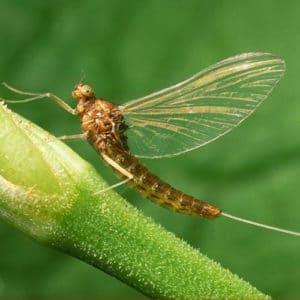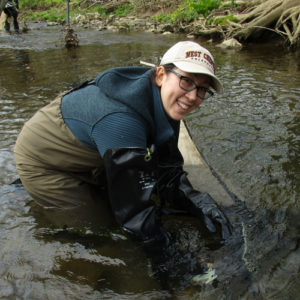
Neocloeon triangulifer adult. Photo: David Funk.
A Trout’s Eye View
The brown trout lurked patiently in a shady pool of White Clay Creek, eyes fixed on the water surface above where her favorite meal would soon appear. She knew today would be her lucky day because increasing water temperature and day length foretold a mass emergence of her favorite delicacy, Neocloeon triangulifer, commonly known as the Triangle Small Minnow Mayfly.
While eagerly anticipating the multiple hatches she would feast on this year from this species of mayfly, a shadow from above darkened her pool. She had company on the river bank over her head: a scientist was crouched ready to collect a few of the mayflies that would soon emerge.
The scientist had come to study a wonder of nature: how could hundreds of individual mayflies on the streambed hatch from their eggs, grow through a dozen nymph life stages over several months, and emerge as adults on exactly the same day?
Scientists at Stroud Water Research Center know Neocloeon triangulifer’s feeding, growth, and behavior from years of study in the stream and experiments in the laboratory (they even patented a family of this mayfly!), but there are some questions too complicated for lab experiments to answer.
Writing Mathematical Equations to “Grow” Mayflies
That’s where computer models come into play: using deep knowledge of this mayfly’s physiology, scientists can write mathematical equations to “grow” an entire creek’s mayflies from egg to adult. Then the model can be used to experiment on these thousands of digital mayflies by exposing them to different patterns of temperature and light, the main cues mayflies use to synchronize their emergence from the stream.

Allison Kolpas, Ph.D., sampling White Clay Creek.
A visiting scholar to the Stroud Center, Allison Kolpas, Ph.D. (Department of Mathematics, West Chester University of Pennsylvania), teamed up the Stroud Center’s entomologists David Funk, John Jackson, Ph.D., and Bern Sweeney, Ph.D., to conduct a modeling study that revealed a new twist on how Neocloeon triangulifer synchronizes emergence so precisely.
They discovered that the pause in mayfly development over the winter helps all the individuals in the population match their timeline for emergence. While scientists previously knew the mayflies overwintered in this way, the model helped them discover how important this behavior was to their ultimate survival.
This discovery paves the way for scientists to conduct the laboratory studies that are needed to better understand how our warming planet may challenge the survival of our trout’s favorite food.
Related Publications
Kolpas, A., D.H. Funk, J.K. Jackson, and B.W. Sweeney. Phenological modeling of the parthenogenetic mayfly Neocloeon triangulifer (Ephemeroptera: Baetidae) in White Clay Creek. 2020. Ecological Modeling 416, 108892.
Neocloeon triagulifer has been used at the Stroud Center to investigate a number of environmental stressors including
- Chronic thermal stress
- Short-term thermal stress
- Toxicity of road de-icing salts
- Bioaccumulation of arsenate
- Coal ash constituents
- Elevated major ion concentrations similar to those observed in oil and gas drilling or coal mining.



